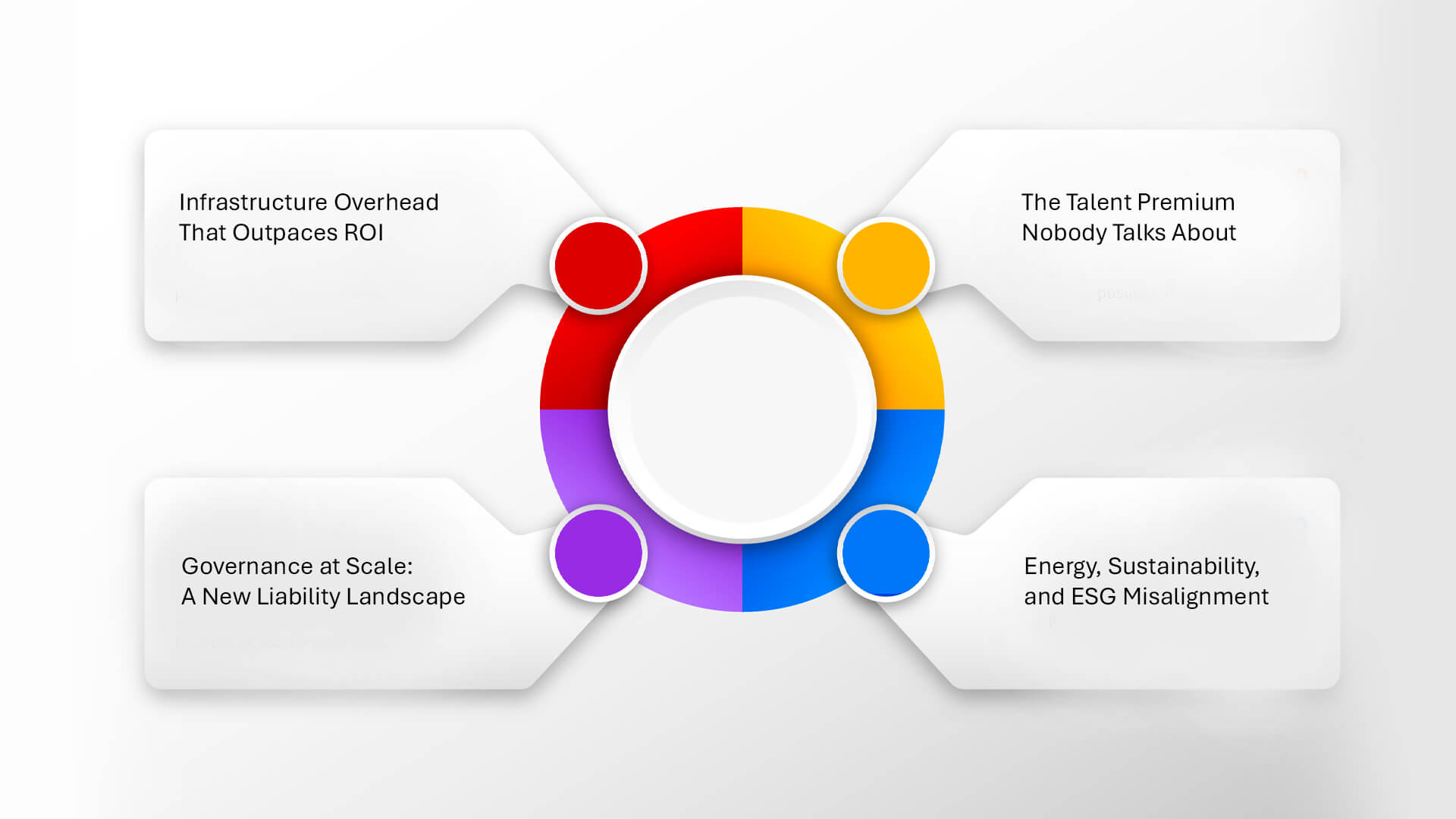In a world where AI defines global competitiveness, data sovereignty has emerged as both a policy mandate and a corporate ambition. Nations are building digital fortresses, while enterprises are racing to align their AI strategy with local laws, ethical standards, and security expectations. This movement, often framed as “Sovereign AI,” promises a new era of control, where data stays within borders, models are governed internally, and compliance is built by design.
But beneath the political clarity and compliance headlines lies a messy, expensive, and often misunderstood reality for enterprises.
Sovereign AI isn’t just about location—it’s about autonomy. And autonomy, as businesses are starting to discover, comes at a steep, hidden cost.
The Rise of Sovereign AI: A Response to a Fractured Digital World
The global momentum behind sovereign AI isn’t just a trend—it’s a direct response to rising geopolitical tensions, escalating data privacy demands, and a growing desire for digital self-determination. Around the world, governments are redrawing the map of digital control, and enterprises are being pulled into this reshaping of the AI landscape.
In the European Union, digital sovereignty has become a pillar of its Digital Decade vision, with initiatives like GAIA-X laying the groundwork for federated, interoperable data infrastructures that prioritize local control. India’s Digital Personal Data Protection (DPDP) Act and Saudi Arabia’s Personal Data Protection Law (PDPL) echo similar ambitions, tightening rules around how citizen data is stored, processed, and shared, particularly when it comes to foreign platforms and cloud providers. Even the United States, long a champion of open digital markets, is now refining its stance with executive orders on AI that impose stricter guardrails on sensitive technologies and cross-border data transfers.
These policy shifts aren’t just macro-level events—they’re landing squarely on enterprise doorsteps.
Chief Information Security Officers and Chief Data Officers are now under pressure to ensure that their AI systems aren’t just high-performing, but also regionally compliant, fully auditable, and ethically aligned. The question has evolved from “Is our AI accurate?” to “Is our AI sovereign, explainable, and defensible under regulation?”
In response, many organizations are taking matters into their own hands—literally. From sovereign cloud deployments and region-specific compute clusters to internally managed model pipelines, enterprises are investing in building AI infrastructure that lives within their national or organizational borders. Banks are retraining algorithms in local zones to comply with data localization mandates. Healthcare providers are modeling patient outcomes on sovereign platforms to meet bioethics and privacy requirements.
But with each layer of control comes another layer of complexity.
And here lies the paradox: the more companies invest in building sovereign AI systems to meet compliance and governance needs, the more they inherit operational overhead, technical debt, and unforeseen cost centers. Without a clear strategy or automation framework, sovereignty quickly becomes less about control and more about complication.
The Hidden Cost Curve: What Enterprises Didn’t Expect

At face value, sovereign AI seems like a rational investment. Control the data. Mitigate regulatory risk. Secure the IP. Own the entire AI lifecycle.
But this control comes at a price—one that is often underestimated in boardroom forecasts.
Infrastructure Overhead That Outpaces ROI
Training and running AI models—especially large language models or deep learning algorithms—requires significant compute power. Sovereign AI mandates often imply on-premise GPU clusters or tightly controlled sovereign cloud zones. These setups are not only capital-intensive to build, but also operationally demanding to maintain.
According to Gartner, enterprises shifting to sovereign AI models are seeing infrastructure costs increase by up to 3–5x compared to traditional cloud-based deployments. Power, cooling, redundancy, latency optimization, and network throughput—each adds another layer of cost and complexity.
And unlike the cloud, where compute can scale elastically, on-prem deployments often sit idle during non-peak hours—wasting energy and underutilizing investment.
The Talent Premium Nobody Talks About
Sovereign AI demands highly specialized roles—data engineers, MLOps professionals, AI model auditors, compliance technologists, and security architects. These aren’t roles you can fill overnight, and their scarcity drives salaries up.
IDC’s recent report on AI Sovereignty in Europe highlighted a talent shortage as the #1 barrier to effective implementation, with over 68% of organizations lacking internal capability to build and govern sovereign models end-to-end.
What starts as a compliance strategy quickly becomes a hiring dilemma.
Governance at Scale: A New Liability Landscape
When enterprises own the full AI pipeline—data ingestion, training, validation, deployment—they also own the entire governance chain. That means accountability for model drift, data bias, access control, explainability, auditability, and ethical oversight.
This is not just about IT hygiene—it’s legal exposure.
A sovereign AI model trained on internal HR data, for instance, must comply with employee privacy laws, bias mitigation standards, and retention mandates. Without automated governance frameworks, each model becomes a potential risk vector.
Gartner warns that by 2026, 40% of sovereign AI implementations will face regulatory violations due to insufficient policy automation and audit trails.
Energy, Sustainability, and ESG Misalignment
Sovereign AI also has environmental consequences. Running high-performance compute clusters 24/7 increases an organization’s energy footprint, at a time when ESG metrics are under scrutiny from investors and regulators.
A recent study found that enterprise AI workloads contribute to over 15% of total data center energy consumption in AI-forward industries like finance and pharmaceuticals. With sovereign AI, the shift away from shared cloud infrastructure to self-managed data centers exacerbates this carbon burden.
So now, CIOs are juggling sovereignty with sustainability—and often finding the two at odds.
A Better Path: Sovereignty On-Demand
So, how can enterprises pursue sovereign AI without sinking into spiraling cost, complexity, and risk?
The answer is not to abandon sovereignty, but to reframe how it’s achieved.
Instead of building full-stack sovereign AI from scratch, forward-thinking organizations are adopting a modular, policy-driven approach we call Sovereignty On-Demand.
Here’s how it works.
1. Federated Data Zones, Not Monolithic Stacks
Instead of forcing all workloads into a sovereign environment, organizations segment their AI landscape. Sensitive workloads—those involving PII, financial data, or proprietary IP—are routed through sovereign enclaves, either on-prem or in region-specific sovereign clouds. Non-sensitive workloads remain in elastic public clouds, reducing operational drag.
This “zone-based” design is already being adopted in Europe through GAIA-X aligned architectures and by private banks that operate multi-region AI deployments with regional controls.
2. Automated Policy Enforcement with Governance-as-Code
Rather than manually checking data flows and model compliance, enterprises are embedding governance directly into infrastructure. Tools like Terraform, OPA (Open Policy Agent), and Kubernetes-native admission controllers can enforce rules about where data resides, which models access what datasets, and who has visibility into inference results.
Zubin, for example, integrates AI-powered policy engines with federated metadata insights, enabling organizations to route data and models according to jurisdictional requirements, without slowing down innovation.
3. AI Workload Optimization and Energy-Aware Scheduling
Not every AI workload needs a 400W GPU. Enterprises adopting sovereignty-on-demand use intelligent workload scheduling to right-size compute usage. Lightweight models like retrieval-augmented generation (RAG), domain-specific SLMs, or open-source quantized LLMs are used where possible.
Energy-aware scheduling ensures that compute-intensive workloads are executed during off-peak grid hours, aligning with sustainability goals while reducing costs.
4. Self-Service, But Secure
By abstracting complexity through self-service interfaces, organizations empower data owners and developers to build AI use cases within guardrails. This enables scale, without sacrificing control.
RBAC, dynamic redaction, file-level encryption, and reclassification of sensitive data ensure that even decentralized teams operate securely under sovereign policies.
Strategic Outcomes That Matter
Done right, sovereignty-on-demand offers the best of both worlds: control and agility.
Enterprises can:
- Accelerate innovation without breaching compliance
- Optimize compute spend through workload-aware orchestration
- Strengthen trust with regulators, customers, and partners
- Maintain ESG alignment while operating sovereign clusters
- Reduce the governance burden through intelligent automation
And most importantly, they regain the ability to innovate responsibly at scale.
Sovereign AI is no longer a choice. It’s a necessity, driven by regulation, risk, and resilience. But how you implement it matters more than whether you implement it.
Zubin: Enabling Sovereignty Without Sacrificing Agility
For enterprises navigating the complex terrain of sovereign AI, the challenge isn’t just infrastructure—it’s visibility, control, and automation at scale. This is where Zubin, Data Dynamics’ AI-powered self-service data management software, becomes pivotal.
Zubin sits at the intersection of governance and innovation. It enables organizations to discover, classify, and govern unstructured data across hybrid and multi-cloud environments, with region-aware policy enforcement and intelligent automation. That means sensitive data can be dynamically routed to sovereign zones, while non-sensitive workloads continue to operate in public cloud environments—aligning with the sovereignty-on-demand framework.
With built-in role-based access controls, federated metadata analytics, file-level encryption, and automated remediation, Zubin helps enforce jurisdictional policies without slowing down development cycles. It empowers data owners to act within boundaries, reducing dependency on centralized teams and enabling secure AI operations across geographies.
In a world where sovereignty is no longer optional, but agility is still essential, Zubin offers a foundation where both can coexist. It helps enterprises shift from reactive compliance to proactive governance, without losing sight of speed, scale, or trust. To know more about Zubin and try it firsthand, visit – https://www.datadynamicsinc.com/request-a-demo/






